When real revolutions happen in significant countries – as in Iran in 1978 or Egypt in 2011 – millions of people pour out on the streets throughout the country and bring everything to a standstill. In the current “revolution” underway in Pakistan, activity is limited largely to a couple of square kilometers in Islamabad and a few specific locations in other cities. The number of people involved at any one location has never exceeded about 40,000 (combined), and currently is far, far lower. And even among these, many come in just for the music concerts. The revolutionary leaders sit in their airconditioned, bullet-proof containers, delivering periodic sermons consisting of vague generalities spiced up with colorful or apocalyptic language. The followers, ragged after weeks of revolutionizing, are roused to dramatic but ultimately ineffectual frenzies. Tear gas fills the air; rubber bullets fly; people get beaten and beat up policemen. TV anchors and analysts cheer or excoriate this or that side. In the rest of the country, life continues as normal, albeit with an undercurrent of tension.
By Ali A. Minai, from the blog of Brown Pundits, as appeared on AsiaPeace
There is no doubt that Imran Khan has the personal support of millions of Pakistanis, but it is now clear that these come mainly from a few highly influential but numerically small segments of society: The educated urban middle and upper-middle class, expatriate Pakistani professionals, and perhaps some segments of the armed forces. The first two – especially their youthful cohorts – are very vocal and able to generate large amounts of cash, but numerically they are no match for the silent, mostly lower and lower-middle class, often rural followers of other major parties such as the PML-N or the PPP. Nor are they as committed to their leader in deed (as opposed to invective) as MQM followers are to theirs.
It is true that almost all successful revolutions are driven by the social segments where Imran Khan has his greatest following, but there are two important differences. First, in most of those cases, these segments form a larger proportion of the country than in Pakistan. In countries like Iran and Egypt, the populations as a whole are much more educated and, in Egypt’s case, much more urban. Second, the remaining segments of society in these countries are not as much in thrall to reactionary forces as in Pakistan, where vast majorities of them vote based on feudal allegiance, religious affiliation, kinship ties, and personal loyalty to politicians. These large population groups are thus largely immune to the rationally-grounded message presented by leaders such as Imran Khan (in his case, very imperfectly). Revolution will occur in Pakistan only when a leader connects with almost the entire population at such a visceral level that people willingly give up their allegiances of generations upon generations to follow the new leader. In a religious, conservative society like Pakistan, the only basis for such a movement is religion, which is also the most dangerous – especially given the religious strains lately ascendant in Pakistan. It is worth remembering that even in Iran and Egypt, the revolutions brought forth rulers who were religious fundamentalists, not liberal democrats. And in Egypt this led directly to the failure of the revolution.
Thus, it would perhaps be just as well if the Great Pakistani Revolution is postponed until a time when religious fervor has been diluted by modernity, or until people are so fed up that they are willing to look at radical new alternatives rather than seeing solutions from the distant past. Meanwhile, we still have “democracy” – or at least something that looks like it – if we can keep it.
Note – This brief piece Ali A. Minai wrote on the events in Pakistan, on:










